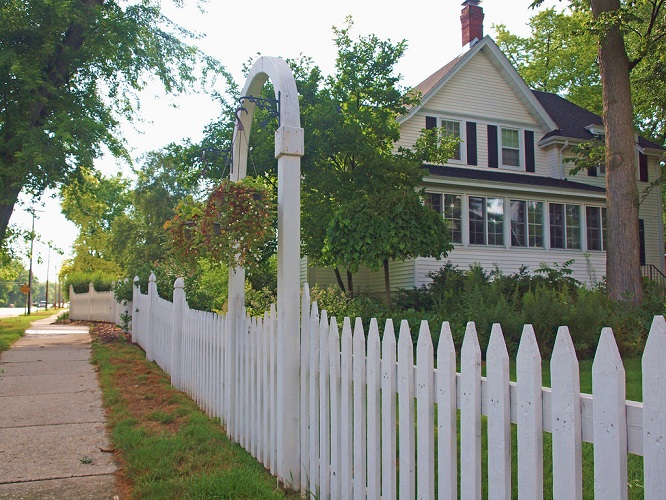How To Landscape Around An Outdoor Fence
When it comes to outdoor space, landscaping along a fence is a default process. This method allows you to conceal the fence line, providing more privacy, and enhancing intimate events that take place in the yard. Here are some ideas to consider for enhancing the look of your outdoor fence:
-
Choose an Appropriate Plant
The first step is to choose an appropriate plant for the fence. There are many types of ornamental grasses that you can use as borders for your fence. Plant them in layers and add color to your yard. Ornamental grasses are a great choice for long fences, as they add movement and add to the aesthetic of your backyard.
Flowering perennials and herbs are also great options for the front of the fence. Using an attractive plant, flower, or shrub combination, you can transform your backyard into a beautiful outdoor area. Whether it’s a privacy fence, a boundary fence, or a garden fence, landscaping along the fence can be a beautiful and effective way to enhance privacy.
-
Front of the Outdoor Fence
For the front of the fence, plants should be curving in shape. Nature doesn’t create things in straight lines, and your landscaping should be too. Straight lines make the landscaping look unnatural and artificial. To achieve the best effect, choose plants with natural curves. Don’t plant flowers in straight rows, as this will highlight the stark lines of your landscape fence. Make sure your flower beds are spread out for optimal visual impact.
-
Determined the Shape of your Garden Fence
Once you have determined the shape of your garden fence, you can plant plants that soften its effect and blend in with the rest of the yard. However, make sure to leave enough space between your plants and the fence if you plan to stain or paint it. Creating a curving bed of plants is another way to soften the hard lines of the fence. For a more natural look, plant a variety of shrubs and climbing plants to disguise the fence.
-
Outdoor Entertainment Space with Landscaping Around
You can also create an outdoor entertainment space with landscaping around it. By using various plants, you can create a combination of flowers, shrubs, and perennials to give the fence a unique appearance. Remember that this area should complement the existing landscaping so that it blends in well. In addition, you should also consider a fence that is decorative to help create a sense of privacy.
-
Curved flower beds –
Whether you have a curving bed or a sharp line, curving flower beds will soften the appearance and blend in with the rest of your yard. Remember to leave enough space between your plants and the landscape fence if you plan to stain or paint it. Plants that grow in a curving bed will soften the hard line of a fence.
-
Raised Garden beds –
Depending on your budget and landscaping style, you can use raised beds as a border around your outdoor fence. Plant layers of greenery and flowers in these areas to create complementary colors in the yard.
Mid-western-style fence landscaping incorporates xeriscape elements, including cacti and bowl cacti along the fence line. You can also use stacked stone pillars to accent your outdoor fence. Stacking stone pillars topped with flowering plants and potted shrubs are the perfect accent for this design style.
Alternatively, you can build a privacy fence by installing a wooden freestanding screen. The wood is durable and can be stained to match the color of your home. If you are planning to fence your backyard, you should also consider planting shrubs and trees around the perimeter of the fence. The choice between a traditional fence and a privacy fence will depend on your personal preference. Another simple method of fencing your outdoor area is with a wooden slat fence.
This rustic style adds visual charm to your yard and helps contain a garden while still letting in enough natural light. This style of fence requires little equipment and a nail gun. The fence itself can be a focal point for your landscape. However, make sure you keep plants well away from the fence so that they do not impede your landscape.
If you’re planning a fence installation project, consider Austin Fence Company. This Company also repairs and replaces fences. You can rely on these professionals to install any type of fence, including security fences, privacy fences, and ornamental wooden fences. Click on this link https://www.truebuiltfencing.com/ to check out their website and to know more about the services they offer.
you can check here on Google Map:
https://www.google.com/maps?cid=9771978836800454208
HOW MANY FENCE POSTS PER ACRE?

Read More: Complete Guide on Buying Composite Fencing
How Many Landscape Staples Do I Need
To determine the right landscape staples, calculate the amount of fabric you need for your outdoor space and install one per 8 to 12 inches. If your ground is loose, use a larger gauge, as the pins will splay out and snag the fabric. Also, make sure to purchase the appropriate landscape staples for the type of soil you have.
You should use landscape staples that are strong and durable. You should also consider the soil type because if your soil is soft, it could cause the fabric to loosen. If you are planting trees, use long landscape staples to keep the ground from shifting. If you have hard, compact soil, choose a smaller gauge.
How Much Does Garden Fence Cost
The cost of a fence installation can range from around $1,667 and $4,075. However, the price of a fence can be much higher, depending on how much material you choose, the height and style, and the terrain. On average, a garden fence installation can cost between $12 and $35 per linear foot.
Pressure-treated pine costs around $3 per linear foot. Other woods cost anywhere from $4 to $15 per linear foot. The more durable wood, the less expensive the price per foot. And the fence should be made of a material that will not decay or rot. You will also need to stain or paint it regularly. If you want to avoid rotting, you may want to go with a wooden fence.










